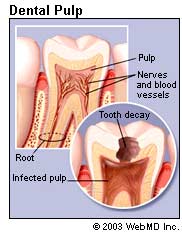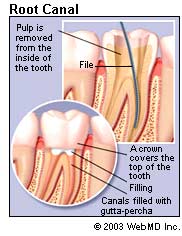People fear root canals because they assume they are painful. Actually, most people report that the procedure itself feels similar to having a filling placed. The discomfort experienced in the period leading up to seeking dental care is truly painful, not the procedure itself.
What Is Dental Pulp?
 The pulp or pulp chamber is the soft area within the center of the tooth and contains the nerve, blood vessels, and connective tissue. The tooth’s nerve is in the “root” or “legs” of the tooth. The root canals travel from the tip of the tooth’s root into the pulp chamber.
The pulp or pulp chamber is the soft area within the center of the tooth and contains the nerve, blood vessels, and connective tissue. The tooth’s nerve is in the “root” or “legs” of the tooth. The root canals travel from the tip of the tooth’s root into the pulp chamber.
A tooth’s nerve is not vitally important to a tooth’s health and function after the tooth has emerged through the gums. Its only function is sensory — to provide the sensation of heat or cold. The presence or absence of a nerve will not affect the day-to-day functioning of the tooth. However, after treatment, the tooth is less viable and more susceptible to fracture.
Why Does the Pulp Need to Be Removed?
When pulp is damaged, it breaks down, and bacteria begin to multiply within the pulp chamber. The bacteria and other dying pulp remnants can cause an infection or abscessed tooth. An abscess is a pus-filled pocket that forms at the end of a tooth’s root. In addition to an abscess, an infection in the root canal of a tooth can cause:
- Swelling that may spread to other areas of the face, neck, or head
- Bone loss around the tip of the root
- Drainage problems extending outward from the root. A hole can occur through the side of the tooth, with drainage into the gums or through the cheek into the skin.
What Damages a Tooth’s Pulp in the First Place?
A tooth’s pulp can become irritated, inflamed, and infected due to deep decay, repeated dental procedures on a tooth, large fillings, a crack or chip in the tooth, or trauma to the face.
What Are the Signs That Root Canal Therapy Is Needed?
Signs you may need root canal therapy include:
- Severe toothache pain upon chewing or application of pressure
- Prolonged sensitivity (pain) to hot or cold temperatures (after the heat or cold has been removed)
- Discoloration (darkening) of the tooth
- Swelling and tenderness in nearby gums
- A persistent or recurring pimple on the gums
Sometimes no symptoms are present.
The Root Canal Procedure
Root canal therapy requires one or more office visits and can be performed by a dentist or endodontist. An endodontist is a dentist who specializes in the causes, diagnosis, prevention, and treatment of diseases and injuries of the teeth’s dental pulp. The choice of which type of dentist to use depends to some degree on the difficulty of the root canal procedure needed in your particular tooth and the general dentist’s comfort level in working on your tooth. Your dentist will discuss who might be best suited to perform the work in your particular case.
 The first step in the procedure is to take an X-ray to see the shape of the root canals and determine if there are any signs of infection in the surrounding bone. Your dentist or endodontist will then use local anesthesia to numb the area near the tooth. Actually, anesthesia may not be necessary, since the nerve is dead, but most dentists still anesthetize the area to make the patient more relaxed and at ease.
The first step in the procedure is to take an X-ray to see the shape of the root canals and determine if there are any signs of infection in the surrounding bone. Your dentist or endodontist will then use local anesthesia to numb the area near the tooth. Actually, anesthesia may not be necessary, since the nerve is dead, but most dentists still anesthetize the area to make the patient more relaxed and at ease.
Next, to keep the area dry and free of saliva during treatment, your dentist will place a rubber dam (a sheet of rubber) around the tooth.
An access hole will then be drilled into the tooth. The pulp, along with bacteria and related debris, is removed from the tooth. The cleaning-out process is accomplished using root canal files. A series of these files of increasing diameter are each subsequently placed into the access hole and worked down the full length of the tooth to scrape and scrub the sides of the root canals. Water or sodium hypochlorite is used periodically to flush away the debris.
What Should One Expect After Root Canal Therapy?
Root canal therapy should relieve the pain you feel. Until your root canal procedure is completely finished — that is, the permanent filling is in place and a crown, if needed, is in place — it’s wise to minimize chewing on the tooth under repair. This step will help avoid recontaminating the tooth’s interior and also may prevent a fragile tooth from breaking before the tooth can be fully restored.
For the first few days following the completion of treatment, the tooth may feel sensitive due to natural tissue inflammation, especially if there was pain or infection before the procedure. This sensitivity or discomfort usually can be controlled with over-the-counter pain medications such as ibuprofen (Advil, Motrin) or naproxen (Aleve). Most patients can return to their normal activities the next day.
As far as oral health care is concerned, brush and floss as you regularly would, and see your dentist at normally scheduled intervals. Because the final step of root canal therapy is the application of a restoration such as a crown or a filling, it will not be obvious to onlookers that a root canal was performed.
Root canal treatment is highly successful; the procedure has more than a 95% success rate. Many teeth repaired with root canal therapy can last a lifetime.
Complications of Root Canal Therapy
Despite your dentist’s best efforts to clean and seal a tooth, new infections might emerge. Among the likely reasons for this include:
- More than the normally anticipated number of root canals in a tooth (leaving one of them uncleaned)
- An undetected crack in the root of a tooth
- A defective or inadequate dental restoration that has allowed bacteria to get past the restoration into the inner aspects of the tooth and recontaminate the area
- A breakdown of the inner sealing material over time, allowing bacteria to recontaminate the inner aspects of the tooth
Sometimes re-treatment can be successful. Other times, endodontic surgery must be tried in order to save the tooth. The most common endodontic surgical procedure is an apicoectomy or root-end resection. This procedure relieves the inflammation or infection in the bony area around the end of your tooth. In this procedure, the gum tissue is opened, the infected tissue is removed, and sometimes the very end of the root is removed. A small filling may be placed to seal the root canal.
Alternatives to Root Canal Therapy
Saving your natural teeth is the very best option, if possible. Your natural teeth make it possible for you to eat a wide variety of foods necessary to maintain proper nutrition. Root canal therapy is the treatment of choice.
The only alternative to a root canal procedure is having the tooth extracted. The tooth would then be replaced with a bridge, implant, or removable partial denture to restore chewing function and prevent adjacent teeth from shifting. These alternatives not only are more expensive than a root canal procedure but require more treatment time and additional procedures to adjacent teeth and supporting tissues.
Since some of the reasons that a tooth’s pulp becomes inflamed and infected are deep decay, repeated dental procedures on a tooth, and large fillings, following good oral hygiene practices (brushing twice a day, flossing and using an antiseptic mouthwash at least once a day, and scheduling regular dental visits) may reduce the need for a root canal procedure. Trauma resulting from a sports-related injury can be reduced by wearing a mouthguard.
